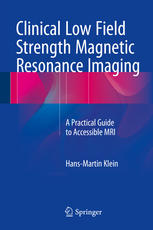

Most ebook files are in PDF format, so you can easily read them using various software such as Foxit Reader or directly on the Google Chrome browser.
Some ebook files are released by publishers in other formats such as .awz, .mobi, .epub, .fb2, etc. You may need to install specific software to read these formats on mobile/PC, such as Calibre.
Please read the tutorial at this link: https://ebookbell.com/faq
We offer FREE conversion to the popular formats you request; however, this may take some time. Therefore, right after payment, please email us, and we will try to provide the service as quickly as possible.
For some exceptional file formats or broken links (if any), please refrain from opening any disputes. Instead, email us first, and we will try to assist within a maximum of 6 hours.
EbookBell Team

0.0
0 reviewsThis book covers all aspects of low field MRI, describing its advantages, problems and prerequisites. Individual chapters are devoted to site planning, safety considerations, coils, imaging technique, image quality optimization, the imaging of different anatomic regions and likely future developments. The factors that must be borne in mind when selecting a low field system are clearly identified and detailed attention is paid to the applications for which such a system is adequate.
The focus on high field systems has led to a situation where only a few systems with field strengths lower than 0.5 T survive. Some of these systems possess high field features such as multichannel coils and strong gradients; furthermore, sequence technology and image processing techniques taken from higher field strength systems have resulted in impressive imaging capabilities. While 1.5-T systems will probably continue to remain the standard, low field systems offer advantages such as the feasibility of dynamic joint examinations, improvement of T1 contrast, reduction of “missile effects” and decreased radiofrequency exposure. Low field strength MRI consequently has the potential to contribute to optimal patient management and given comparable image quality, its application may become an issue of patient safety. This book will be an invaluable asset to all who are involved in planning and/or running a low field strength MRI facility.